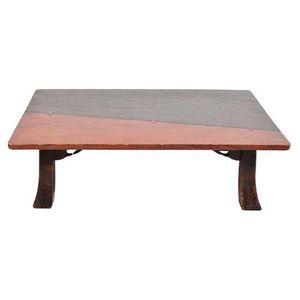French Oak Parquetry Draw Leaf Table
You must be a subscriber, and be logged in to view price and dealer details.
Subscribe Now to view actual auction price for this item
When you subscribe, you have the option of setting the currency in which to display prices to $Au, $US, $NZ or Stg.
- Cabriole Leg - The cabriole leg evolved from an elongated scroll, curving out at the knee which may or may not be carved, and forming a serpentine shape as it descends to the foot.
First introduced into English furniture in the late 17th century, cabriole legs were widely used during the Queen Anne and early Georgian periods, where they frequently terminated in a pad foot or ball and claw foot. The style has had many imitators since then. The cabriole leg was re-introduced in the mid-19th century, and is commonly associated with the balloon-back dining or drawing-room chairs made in walnut, mahogany or, in Australia, cedar. The Victorian cabriole leg, on the whole, was rather more slender than the earlier form, following the French style, which emphasized the delicacy and daintiness of the chairs they were designed to support. Cabriole legs are sometimes found on windsor chairs, especially those made during the 18th century. - Oak - Native to Europe and England, oak has been used for joinery, furniture and building since the beginning of the medieval civilisation. It is a pale yellow in colour when freshly cut and darkens with age to a mid brown colour.
Oak as a furniture timber was superceded by walnut in the 17th century, and in the 18th century by mahogany,
Semi-fossilised bog oak is black in colour, and is found in peat bogs where the trees have fallen and been preserved from decay by the bog. It is used for jewellery and small carved trinkets.
Pollard oak is taken from an oak that has been regularly pollarded, that is the upper branches have been removed at the top of the trunk, result that new branches would appear, and over time the top would become ball-like. . When harvested and sawn, the timber displays a continuous surface of knotty circles. The timber was scarce and expensive and was used in more expensive pieces of furniture in the Regency and Victorian periods. - Frieze - An architectural term denoting the flat, shaped or convex horizontal surface of furniture, between the architrave and the cornice, usually found on a cabinet or bookcase, or on desks and tables where it may include drawers, the area between the top and the legs. In ceramics, the term refers to the banding, of usually a repeating pattern, on the rims of plates and vases.
- Parquetry - Parquetry is inlay laid in geometric patterns, the contrast being achieved by the opposing angles of the grain and veneers. The herringbone pattern is the most commonly used in flooring, but this is almost never seen in furniture - the patterns used are more complex and unlike flooring, can include several different varieties of timber.
This item has been included into following indexes:
Visually similar items

A modern Danish glass-topped stained teak low table, designed in the 1960s by Illum Wikkelso, the rectangular smoked glass top resting on the frame of moulded X-form trestles joined with a stretcher. Height 53 cm length 129 cm. Depth 95 cm

A Victorian mahogany extending dining table. 355 cm fully extended

An unusually long Louis XV oak dining table c1900

A Japanese lacquered low table, 20th century, rectangular in form with a linear iron red lacquer decoration to centre
